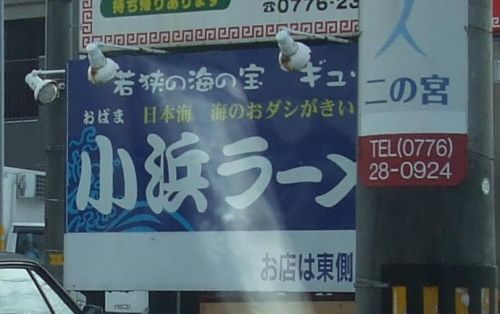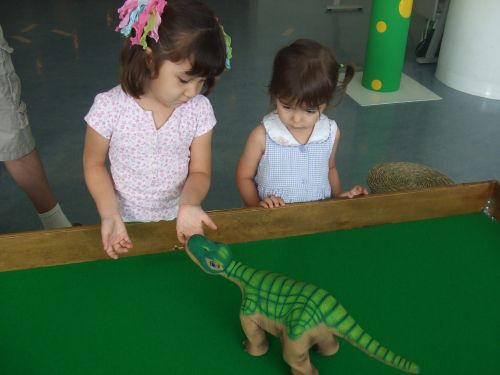Except for my quest to find an internet connection, the first few days here in Imazu were pretty uneventful. Usually we’re too jet-lagged to do much anyway, so it’s fine with us. Yesterday though, we took a trip to Fukui Prefecture with Ryoko’s aunt and uncle.
I’ve blogged a little about Fukui Prefecture before a few years ago, when we went to visit the nuclear power plant located on one of the many peninsulas there. Interestingly enough, that is right next to the city of Obama, which has gained some notoriety due to the name of the U.S. President. We didn’t go to Obama (I’ve been there before though when my father came to meet Ryoko’s parents. There isn’t much to the city, to tell you the truth), but I did manage to take the following picture as we were driving through Tsuruga, a nearby town:

That’s an advertisement for Obama Ramen. Unfortunately my timing was a bit off and the right edge is cut off by a telephone pole.
The first place we went to was the Fukui Prefectural Dinosaur Museum. It turns out the only place where dinosaur fossils have been found in Japan are in Fukui Prefecture, and to commemorate it the prefecture has built what I can only call a truly, truly excellent museum. I like to go to natural history museums anywhere I go, and this is one of the best I have ever seen. It’s built inside of a giant metallic sphere, which makes the museum easy to spot from several miles away, and makes for a really impressive ceiling once you get into the main body of the museum.
Ryoko took a lot of pictures of the museum, but the inside is somewhat dark and flash photography was forbidden, so all the pictures there look like crap. So I’ll try and describe what made it such an excellent museum.
First of all, if you go to a dinosaur museum, you want to see lots of dinosaur skeletons. Well, they are there a plenty. All the famous ones like T. Rex, Brontosaurus, Triceratops, Stegosaurus, etc. One of the big attractions was several full-size dinosaur facsimiles with skin, eyes, etc. that were animatronic! There were 3 velociraptors attacking a medium-size dinosaur. There were speakers inside too so that they also roared as they moved around. Eren (she turns 3 in September) was absolutely terrified. I had to pretty much run through the exhibit with her to go see the rest of the exhibits.
Also all the exhibits had very detailed explanations and didn’t ‘dumb down’ the science at all. This would have been problematic for me since ‘dumbed down’ science would be much easier for me to read in Japanese, but almost every exhibit had English right next to the Japanese. 100% of everything wasn’t translated into English, but probably at least half of everything was, and it was excellent scientific English, none of this ‘Engrish’ that is all too familiar to Westerners in Japan.
For me the most interesting part was that the special exhibit, as many museums have special exhibits that change every few months. The theme of the special exhibit was “Did Dinosaurs See Flowers?â€, and was about the evolution of flowering plants as compared to the dinosaurs, mammals, and insects. What made it so excellent was that there was a graduate student on hand that would answer questions about the exhibits. We spoke in Japanese for Ryoko’s sake, but he had excellent English and could immediately give me the English terms for difficult vocabulary that I didn’t know in Japanese (i.e. the names of the geological epochs, the various biological classifications, etc.).
Aside: I would have been lost without his help, since some of the Japanese technical terms are very non-obvious to a Westerner. The names of the dinosaurs are fairly easy, since they’re just the English names pronounced in Japanese. The epochs though, are strange. Triassic is 三畳紀, which translates to ‘three tatami period’ (tatami are the woven grass mats that floors are made of in Japanese homes, although the character can also be used as a measurement of area, where 1 jou equals the area of one tatami mat, about 3 feet by 6 feet). I’m not really sure where that translation came from. The 3 is obvious with the ‘tri’ in Triassic, but I don’t know Latin to guess the meaning of the suffix, and I don’t have internet access to look it up. Jurassic is a little easier in that it’s just ジュラ紀, or the Jura Period. Cretaceous is again strange, being 白亜紀, which means ‘chalk period’ in Japanese. I would guess that creta means chalk or something similar in Latin and that there is some good reason why the geological period is named after chalk (lots of chalky mineral deposits associated with that period, perhaps), but since such things are not generally known, it means that these words do not have obvious translations that you can guess by just looking at them.
Anyway, I talked to the grad student for almost an hour, asking him about all sorts of things that have always bothered me a bit about dinosaurs. How were dinosaurs able to get so big when there aren’t/weren’t equivalently-sized land animals in other periods? Were dinosaurs slow, lumbering behemoths, or were they quick and agile like we saw in Jurassic Park? About the size of dinosaurs, the grad student told me that a lot of the paleontological community views it as a silly question. He pointed out that first of all, the dinosaurs did exist and flourish for millions of years at their size. So the questions of how they were able to stand, walk around, etc. are pretty silly because they obviously did. Now as to why there aren’t any animals of that size today, he pointed out that even the biggest dinosaurs, like the brontosaurus, supersaurus, diplodocus, etc. weren’t that much larger than the current largest land animal, the African Elephant. In a way, he’s right. The brontosaurs have their extremely long necks and tails, but the actual main body of the dinosaur is maybe only 50% larger than an elephant’s body.
So the museum was great. I would have liked to have spent several more hours reading all the exhibits, but the girls were tired and getting restless. If you’re ever in Japan and go over to Fukui prefecture (no one goes to Fukui prefecture, everyone goes to Tokyo, Kyoto, or Osaka), this museum is great. I would have loved to have my brothers and parents there, they would have all loved it too.

This is Karisa and Eren at one of the children’s exhibits, where they have a robotic baby dinosaur that you can play with. I was really impressed with its programming, it would react to being petted by cooing and wagging its tail, when you picked it up and held it it would fall asleep, and it would avoid bumping into walls when it walked around.

This is one of the full-size dinosaurs. That tree is 50’ high!

With the poor lighting it’s not a very good picture, but when I tell you it’s a circular dome, from the curvature of the wall you can get an idea of the size of the place and the impressive unsupported ceiling. Also if you stood in the right place you could easily hear a conversation at the other end of the hall, and whenever you spoke you would hear your own voice echoing.

Loved the post, sounds like a great museum
Creta is latin for chalk. excellent guess on that one. I believe it was named for the chalk cliffs of dover which were the site of some of the early studies of Cretaceous sediment.
I am not sure that I agree with your graduate student about their size being a silly question. I am not arguing that dinosaurs lived, but that understanding how such enormous animals lived(and importantly supported their own weight) tells us more about the soft tissues that are not recorded in the fossil record. I also disagree that the Ankylosaurus is only a little bigger than an african elephant, though that could be bias on my part.